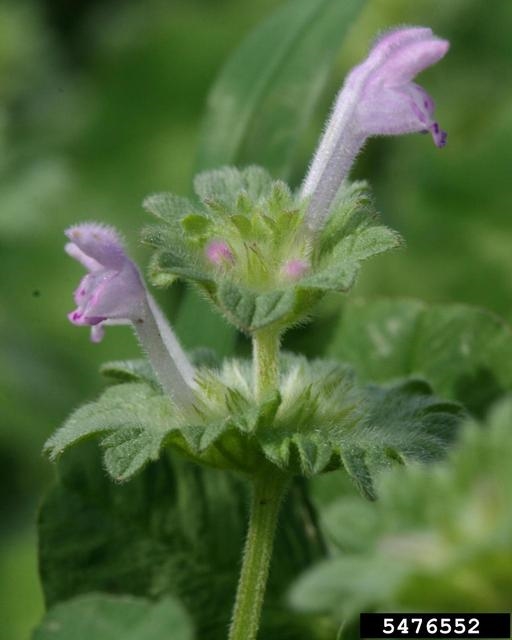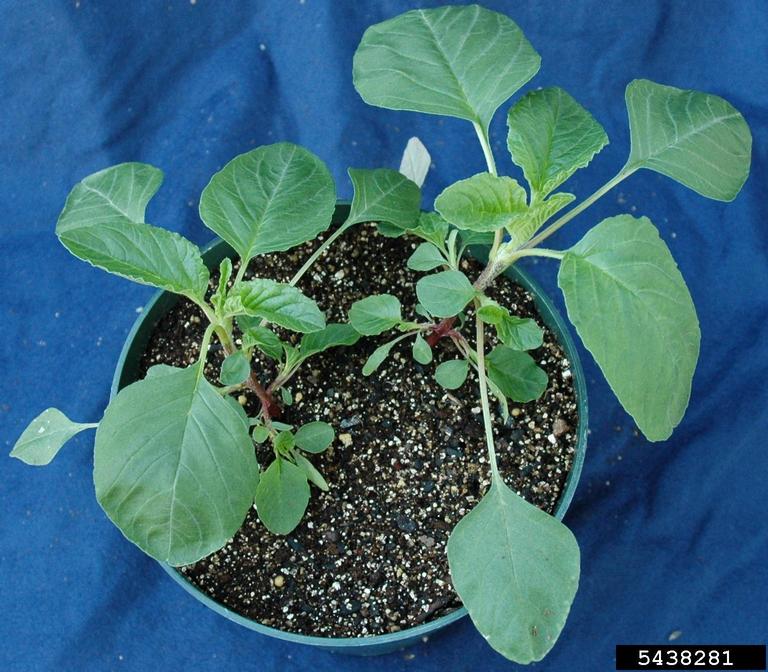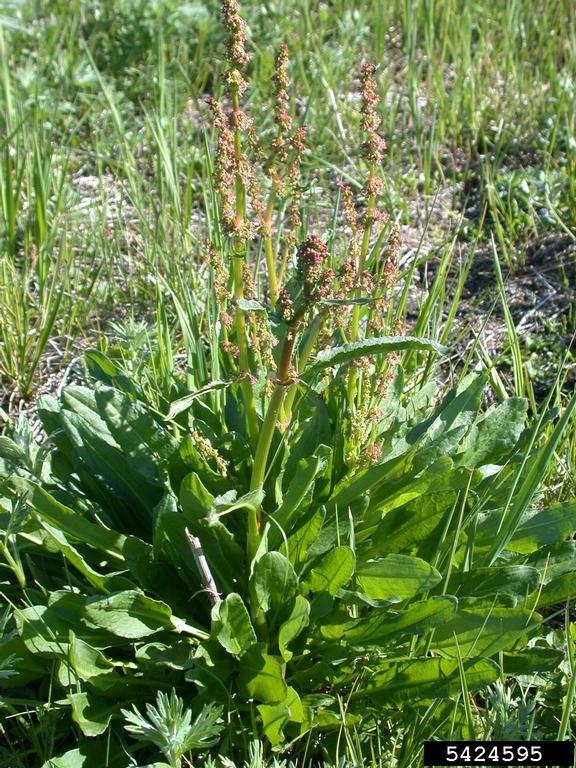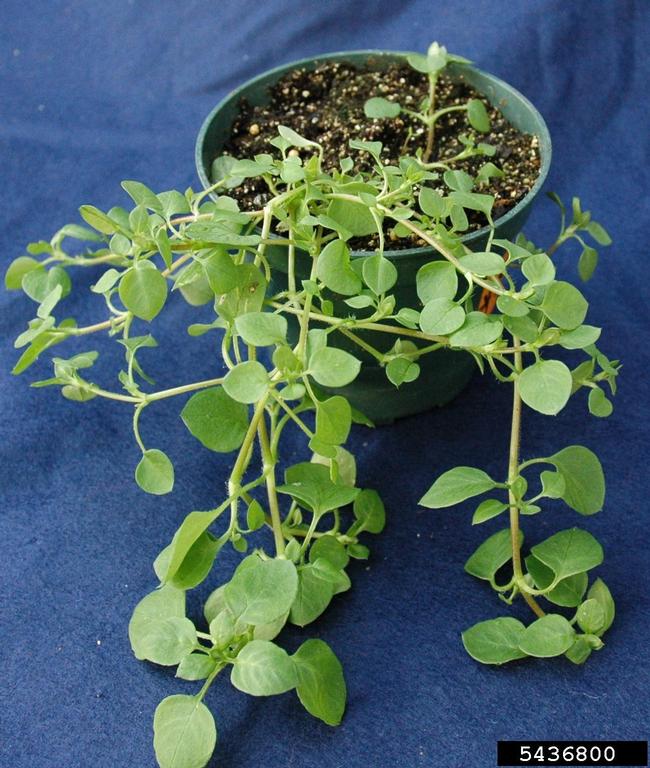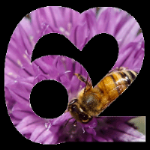Weeds: Thugs and Friends
Weeds envelop our fences, borders, and beds early and quickly unless we remove them regularly and vigorously! The page shows the most common weeds at 62nd and Dorchester, starting with the worst—remove/kill them wherever you see them—to some we tolerate in low numbers. Please be vigilant about weeds in our garden! Spend a few minutes at each visit to weed along sidewalks, paths, everywhere. Study the photos to recognize their various growth stages. It's best to get weeds out while small. (Photos credits: Invasive.org except where noted. See page bottom.)
NOTE ON EDIBLE WEEDS: Some weeds are edible; however, we still keep these in check. If you grow, for example, lambsquarters or purslane to eat, please do so in your own plot and do not allow them to go to seed. We may remove even somewhat tolerable weeds from any community bed or garden box, path, etc., without notice, especially if we can use the spot to grow vegetables. Feel free to forage weeds along garden fences and outside plots. CAUTION: Be sure you can recognize edible plants you did not grow. Two good sites about weed foraging are Edible Wild Food and Eat the Weeds.
MILKWEED: Essential to Monarch Butterflies
Milkweeds (Asclepias sp.) are the sole host plant and food source for Monarch butterfly caterpillars, a hallmark species in rapid decline. We grow a few varieties of milkweeds in the south-facing flower beds on both the east and west sides, and will dedicate more space to them as our crop begins to spread.
PLEASE DO NOT REMOVE THEM FROM THESE BEDS! If milkweed pops up in your plot, if possible, please dig it gently and let one of the garden committee members know so that we can replant it elsewhere. Milkweed will readily spread, and we will be watchful that it does not colonize common areas and plots.
WORST WEEDS: Remove All
Dig these plants wherever you find them! Never add weeds with flowers and seed heads to compost bins. Never compost bindweed.
BINDWEED
Bindweed comes in two types, both having a leaf shaped like a spade/arrowhead, both a serious scourge in our garden. Field bindweed spreads like a mat over the ground, rapidly overwhelming any other plants. Roots are spindly, break easily, and cannot be completely dug out since they grow as deep as 12' or more. Flowers are 1.5 - 2.5" in white or pink. Hedge bindweed is a vine with pink or white flowers up to 3" and resembles morning glory. It spreads by sending out long rhizomes and from seed. For all bindweed, pull off vines that cling to plants or fences, then dig out the root at least a trowel's depth into the soil. Smother the site with thick black plastic, cardboard, or something opaque. Starving the roots is the only organic method of killing these plants.
Kill it wherever you find it. Do not add to compost—dispose in trash.
More: http://www.invasive.org/browse/subinfo.cfm?sub=4338
RAGWEED
Ragweed starts out small with leaves resembling cosmos, but grows to 3' or more. Ragweed pollen is a major cause of allergies, starting late summer through fall. Dig ragweed out as soon as you see it in spring--before flower heads form to disperse pollen and set seed. In loose soil you might be able pull the whole root out. In compacted soil, please dig.
More: http://extension.umass.edu/landscape/weeds/ambrosia-artemisiifolia.
ARTEMISIA/MUGWORT
Artemisia/Mugwort may be the quintessential urban weed, but it has a long history of medicinal use, too. It is a major cause of hay fever in the fall. It is perennial, growing to 6'. Unless you are using this for traditional medicine, please remove it, and always remove seed heads.
More: http://www.invasive.org/browse/subinfo.cfm?sub=5148
TREES
Trees (Sumac/Tree of Heaven/Norway Maple/Mulberry...): We continually cut back and dig trees from around our fence lines. We've removed some sumac with root systems over 10' long! If you find small woody seedlings popping up, dig them at once!
More: http://www.invasive.org/browse/subinfo.cfm?sub=3988 , http://www.invasive.org/browse/subinfo.cfm?sub=3003 , http://www.invasive.org/browse/subinfo.cfm?sub=3002
THISTLES
Thistles are highly invasive and tough to remove once established. If it is sharp and pointy, dig it! More: http://extension.umass.edu/landscape/weeds/cirsium-arvense
HENBIT & DEADNETTLE
Henbit & Deadnettle resemble each other, and neither are welcome. More: http://extension.udel.edu/kentagextension/2009/03/23/winter-annual-weeds-henbit-and-purple-deadnettle/
REDROOT PIGWEED
Redroot Pigweed is a species of Amaranth with edible leaves and seeds. The base of the stem and root are tinged red. Each plant produces tens of thousands of seeds. Native Americans used these as a source of food, and birds enjoy them over winter. In our garden, they will colonize a plot in a matter of weeks, with plants growing densely to 6' and taller. They pull out easily even when 2 or 3' tall. Unless you are harvesting them and removing all seeds, remove pigweed wherever found. More: http://www.invasive.org/browse/subinfo.cfm?sub=5093
SOMEWHAT TOLERABLE: Remove Most
LAMBSQUARTERS
Lambsquarters is edible, flavorful, and used like spinach. It can grow to 6' with a robust taproot. Pull it young and cook it! Don't allow it to flower and set seed.
More: http://www.invasive.org/browse/subinfo.cfm?sub=5294
DOCK
Dock or dockweed is a tough perennial with long broad leaves. Though some dock is a food source for caterpillars, these plants will grow big and crowd out your vegetables. They have a long taproot which is tough to dig out, so find and eliminate them early on.
More: http://www.invasive.org/browse/subinfo.cfm?sub=10106
CHICKWEED
Chickweed is a mat-forming winter annual that can smother small seedlings. Easy to remove. More: http://extension.cropsci.illinois.edu/fieldcrops/weeds/common_chickweed/
PENNYCRESS
Pennycress is tiny and edible, but spreads via seeds.
More: http://www.invasive.org/browse/subinfo.cfm?sub=6524
OTHER WEEDS
These plants can act as a groundcover, holding down the soil and taking up space that worse weeds can't colonize, are good for pollinating insects, or simply don't threaten the garden like others do. We don't mind them in small populations. Our energy is better spent removing the worst weeds, always plentiful.
CLOVER
Clover, red or white, is great for bees and other pollinators. As a legume, it improves the soil by fixing nitrogen. More: http://www.invasive.org/browse/subinfo.cfm?sub=9429
DANDELION
Dandelion: Yellow, edible, great for pollinators, taprooted, ubiquitous. Keep in check and don't allow to set seed. More: http://www.invasive.org/browse/subinfo.cfm?sub=3887
PURSLANE
Purslane leaves and stems are edible and a source of omega-3 fatty acids. It forms a circular mat with small, thick succulent leaves. It can act like a groundcover, and we prefer it to other weeds on our fence edges. Try some in your next salad! Note that a somewhat similar looking plant that has a milky sap is not edible and toxic. More info at http://www.ediblewildfood.com/purslane.aspx
PLANTAIN
Plantain comes in two varieties, one broadleaf and one with a thin strappy leaf. Both are native perennials growing 12-18' tall when flowering. They tolerate trampling, mowing, roadsides, and rubble. Bees like them. Each flower makes few seeds, so they spread slowly.
More: http://www.invasive.org/browse/subinfo.cfm?sub=6201
GOLDENROD
Goldenrod is often confused with ragweed due to its heavy yellow pollen, but bees and other pollinators work for this plant, not the wind. We welcome some in our borders, but keep it in check since it will spread. If you grow it, please don't let it go to seed.
More: http://www.invasive.org/browse/subinfo.cfm?sub=6441
CHICORY
Chicory's blue daisy-like flower tops a wiry nondescript plant. It mixes charmingly with Queen Anne's Lace. Its edible root has famously filled in for coffee. We don't mind this one.
More: http://www.invasive.org/browse/subinfo.cfm?sub=5332
QUEEN ANNE'S LACE
Queen Anne's Lace is perhaps the loveliest so-called weed. Unless this is in your plot and unwelcome, there's no reason to pull it.
More:
MORNING GLORY
Please do not plant cultivated morning glory in your plot or along fences. It is a fast grower and very aggressive and can smother vegetable crops. Morning glory looks a lot like bindweed. Bindweed’s leaves are thinner, shaped like a spade/arrowhead, while morning glory leaves are broader.
Photo Credits:
Image Number Citaton
0016230 James H. Miller, USDA Forest Service, Bugwood.org
1116020 Charles T. Bryson, USDA Agricultural Research Service, Bugwood.org
1119463 Chris Evans, Illinois Wildlife Action Plan, Bugwood.org
1120214 James H. Miller, USDA Forest Service, Bugwood.org
1120254 James H. Miller & Ted Bodner, Southern Weed Science Society, Bugwood.org
1205006 Dave Powell, USDA Forest Service (retired), Bugwood.org
1363425 Mary Ellen (Mel) Harte, Bugwood.org
1380309 Chris Evans, Illinois Wildlife Action Plan, Bugwood.org
1391009 John D. Byrd, Mississippi State University, Bugwood.org
1391311 John D. Byrd, Mississippi State University, Bugwood.org
1459144 Steve Dewey, Utah State University, Bugwood.org
1459421 Steve Dewey, Utah State University, Bugwood.org
1542217 Joy Viola, Northeastern University, Bugwood.org
1550161 Ohio State Weed Lab Archive, The Ohio State University, Bugwood.org
1552251 Theodore Webster, USDA Agricultural Research Service, Bugwood.org
1552252 Theodore Webster, USDA Agricultural Research Service, Bugwood.org
1553068 Theodore Webster, USDA Agricultural Research Service, Bugwood.org
1553154 Ohio State Weed Lab Archive, The Ohio State University, Bugwood.org
1553188 Theodore Webster, USDA Agricultural Research Service, Bugwood.org
1553232 Ohio State Weed Lab Archive, The Ohio State University, Bugwood.org
1554100 Ken Chamberlain, The Ohio State University, Bugwood.org
1557258 Ohio State Weed Lab Archive, The Ohio State University, Bugwood.org
1557393 Ohio State Weed Lab Archive, The Ohio State University, Bugwood.org
2135071 Barbara Tokarska-Guzik, University of Silesia, Bugwood.org
5085003 Mary Ellen (Mel) Harte, Bugwood.org
5090070 Mary Ellen (Mel) Harte, Bugwood.org
5090073 Mary Ellen (Mel) Harte, Bugwood.org
5106083 Mary Ellen (Mel) Harte, Bugwood.org
5139017 Lynn Sosnoskie, University of Georgia, Bugwood.org
5362356 Howard F. Schwartz, Colorado State University, Bugwood.org
5362867 Phil Westra, Colorado State University, Bugwood.org
5370238 Rebekah D. Wallace, University of Georgia, Bugwood.org
5374249 Joseph M. DiTomaso, University of California - Davis, Bugwood.org
5374250 Joseph M. DiTomaso, University of California - Davis, Bugwood.org
5374875 Joseph M. DiTomaso, University of California - Davis, Bugwood.org
5396512 Robert Vidéki, Doronicum Kft., Bugwood.org
5396592 Robert Vidéki, Doronicum Kft., Bugwood.org
5397859 Robert Vidéki, Doronicum Kft., Bugwood.org
5398905 Robert Vidéki, Doronicum Kft., Bugwood.org
5398919 Robert Vidéki, Doronicum Kft., Bugwood.org
5399108 Robert Vidéki, Doronicum Kft., Bugwood.org
5399228 Robert Vidéki, Doronicum Kft., Bugwood.org
5424595 Mary Ellen (Mel) Harte, Bugwood.org
5424599 Mary Ellen (Mel) Harte, Bugwood.org
5429513 Nathan Hobrath, State of Alaska, Bugwood.org
5435794 Eric Coombs, Oregon Department of Agriculture, Bugwood.org
5436800 Bruce Ackley, The Ohio State University, Bugwood.org
5436883 Bruce Ackley, The Ohio State University, Bugwood.org
5437152 Bruce Ackley, The Ohio State University, Bugwood.org
5437156 Bruce Ackley, The Ohio State University, Bugwood.org
5437367 Bruce Ackley, The Ohio State University, Bugwood.org
5438281 Bruce Ackley, The Ohio State University, Bugwood.org
5438587 Bruce Ackley, The Ohio State University, Bugwood.org
5443507 Rob Routledge, Sault College, Bugwood.org
5449058 Leslie J. Mehrhoff, University of Connecticut, Bugwood.org
5449069 Leslie J. Mehrhoff, University of Connecticut, Bugwood.org
5451395 Leslie J. Mehrhoff, University of Connecticut, Bugwood.org
5451406 Leslie J. Mehrhoff, University of Connecticut, Bugwood.org
5476552 Chris Evans, Illinois Wildlife Action Plan, Bugwood.org
5498717 Howard F. Schwartz, Colorado State University, Bugwood.org
5498734 Howard F. Schwartz, Colorado State University, Bugwood.org






















